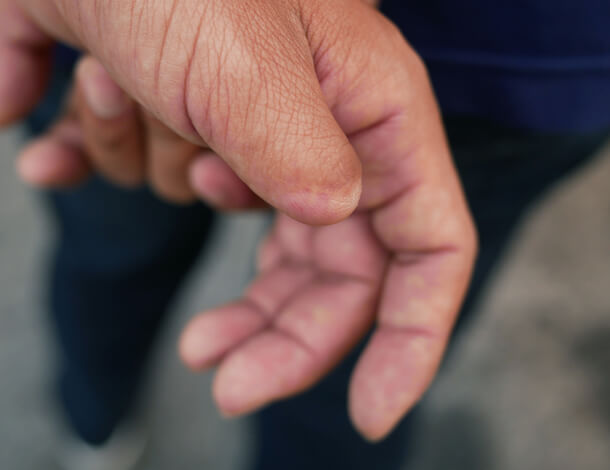Get a Grip on Your Hand Nerve Injury: Diagnosis, Treatment, and Recovery

Your hands are the first and most important tools you’ll ever use. They can create art, build complex structures, write a masterpiece, or soothe a loved one. Through the peripheral nervous system, your hands connect you to the world around you, gathering sensory input and sending it to your brain. But what happens when you suffer a hand nerve injury?
A peripheral nerve injury in your hand can have a significant negative impact on your work, hobbies, relationships, and more. Accurate diagnosis is the first step in creating a plan for proper care and treatment, leading to less pain and overall recovery.
But first, you have to know what you’re dealing with. Nerve damage comes in many forms, but if you’ve suffered an injury in which parts of your hand were crushed, cut, or stretched, you may be noticing the following symptoms:
- Pain: It’s most common to experience pain at the site of the hand injury, but remember that pain can radiate along the peripheral nerves and be felt in other areas of the hand.
- Numbness: Many nerves in the hand transmit sensation, and if they’ve been damaged, you will likely experience a loss of that sensation. This can feel like total numbness or a dullness, tingling, or crawling feeling.
- Weakness: Peripheral nerves are like a telephone line between your brain and your extremities. Damage to the nerves interrupts that communication and leaves the injured area weak and unable to perform basic functions. In the hand, this can affect your grip, muscle control, and range of motion.
A hand nerve injury can be traumatic and disruptive to your daily life, but no matter how severe the damage, help and support are available. Here, we’ll explore types of nerve injuries and diagnoses, surgical treatment options, and how a hand nerve injury doctor can get you on the right path to healing.
Types of Hand Nerve Injuries
Nerve damage in the hands can stem from many causes, including autoimmune diseases (like lupus) or chronic conditions (such as carpal tunnel syndrome or diabetes). However, external injury or trauma is easier to diagnose—you likely know the exact moment your hand was injured, whether it was compressed in a car crash, lacerated while chopping vegetables, or fractured in a fall.
You may already be well on your way to healing from your injury when you notice nerve pain, tingling, or weakness in your hand.
Share Your Symptoms With a Hand Specialist
Whether it happened six days ago, six months ago, or even years ago, if you’re experiencing nerve damage from a hand injury, seeking an accurate diagnosis and urgent treatment is crucial to regaining function and lessening pain.
Diagnosing a Hand Nerve Injury With an EMG & NCS Study
Evaluating the pattern of nerve injury can be done with a clinical exam with a nerve injury specialist. Though sometimes additional information can be obtained with further diagnostic testing. An EMG and NCS is a two-step process that helps ensure accurate pinpointing of nerve damage and can guide specialists in building a better treatment plan. This dual-pronged approach includes a:
- Nerve Conduction Study: An NCS involves placing electrodes on the skin over the suspected damaged nerves. Electrical impulses are sent through the electrodes, and the transmission of those impulses is recorded.
- Electromyography: EMG goes one step further and tests nerve transmission by inserting electrodes under the skin. You will then be asked to move your hand by contracting and releasing your muscles while recording the results.
NCS and EMG are reliable ways to determine which nerves have been damaged due to your hand injury and will guide your specialist in determining the right course of action. The tests are minimally invasive and should be completed within 40 minutes. During the NCS, you may feel a mild shocking sensation, and during the EMG, you can expect some slight discomfort—about what you’d expect from any shot.
You may have some light bruising or tenderness at the site in the days following the procedures.
At IHTSC, we perform electromyography and nerve conduction studies on-site at multiple locations, offering a convenient way to get your diagnosis and plan your next steps in one stop. To prepare for a testing appointment:
- Wear non-restrictive clothing (avoid anything with a tight wrist/sleeve)
- Remove all rings and bracelets
- Wash your hands
- Do not apply lotion or cologne
Speaking of next steps, once you’ve received your diagnosis and specialists have pinpointed the damaged nerves, it’s time to consider all the solutions available to relieve nerve pain and help you heal.
Innovative Surgical Solutions
Having a surgical procedure to relieve pain from a peripheral nerve injury in your hand may seem drastic to some, but today’s technological advances have led to new and innovative techniques that are less invasive, more effective and require less downtime.
At IHTSC, our specialists are forging new paths in treating nerve injury pain with nerve grafting, transfers, and direct repair procedures. Surgical solutions your physician may recommend can include:
- Nerve Repair with or without a conduit or nerve grafting
- Targeted Muscle Reinnervation (TMR, a form of nerve transfer)
- Nerve End Capping
- Vascularized, Denervated Muscle Targets or Regenerative Peripheral Nerve Interface (RPNI)
Learn About Surgical Options for Nerve Pain Relief
Many procedures involve redirecting or rerouting damaged nerves into healthy tissue, so they can fully heal without causing unnecessary pain. At IHTSC, our precision tools and experienced specialists can drill down to the exact location of your nerve pain and address it right at the source.
Options for Treating Peripheral Nerve Pain After Amputation
If your hand injury resulted in an amputation of one or more fingers or even in other locations of the arm, it’s not uncommon for you to experience phantom nerve pain. Aside from the pain itself, this can be an unpleasant and unwanted reminder of a traumatic event, but it can be dealt with.
Several of the procedures listed above are also recommended for amputees, along with other surgical techniques, such as:
- Targeted Muscle Reinnervation (TMR): TMR reroutes nerves severed during amputation into healthy tissue, where they can recover, all while lessening pain.
- Regenerative Peripheral Nerve Interface (RPNI): RPNI uses a muscle graft to offer a healthy target for healing damaged nerves.
If your physician recommends surgery as a hand nerve injury treatment, you’ll want to be as prepared as possible to shorten your recovery time and get back to living pain-free.
Post-Surgery Care and Rehabilitation
Immediately after surgery, your primary goals are to rest, reduce swelling, and manage pain. Follow your physician’s instructions to the letter, including keeping your hand/arm elevated, and using ice packs and anti-inflammatories. Splinting may be necessary to protect the surgery initially.
Remember that you may still experience hand nerve pain after surgery, but if it becomes extreme, reach out to your provider.
After initial healing from surgery, your physician will likely recommend physical and/or occupational therapy. In our globally recognized Therapy Center, IHTSC occupational therapists will work with you to regain function and return to daily life with maximum use of your affected hand. Hand occupational therapy may involve working on your grip and range of motion through custom exercises, heat therapy, massage therapy, splinting, and more.
Remember that after a hand nerve injury with peripheral nerve damage, you’ll need to exercise patience and determination to return to your pre-injury routine. At IHTSC, our specialists are here to help you every step of the way.
See a Hand Nerve Injury Specialist at IHTSC
What if help and healing for peripheral nerve injury was at your fingertips? It can be when you trust the team at IHTSC. Our hand specialists take a collaborative approach to your healing, so you know you’re getting combined decades of wisdom, experience, and expertise.
Benjamin, an IHTSC patient, learned firsthand when he suffered a traumatic hand injury and was left with excruciating nerve pain in his hand and arm. “I was trying to get help, and nobody really believed me,” he says. “They just kept telling me to get back to work.“
And Benjamin is not alone. According to the Bureau of Labor Statistics, hand injuries are the second most common among U.S. workers. Fortunately, Benjamin visited IHTSC, where Brandon S. Smetana, M.D., found a neuroma—a balled-up section of nerve sending incorrect or pain signals to the brain—which was then removed, and the gap filled with a nerve graft. Benjamin experienced an immediate reduction in pain, which improved over time.
“When I was able to get back to work, I felt really good,” he says. “I can provide for my family again, which means a lot to me. I’m a survivor one way or another, and it made me feel good to start surviving again.”
If you’re experiencing pain from a hand nerve injury, the time to act is now. We can do our part to get you back to work like Benjamin and back to life. But the first step is yours to take. Take it now, and call us at (317) 751-5904 to book an appointment (or schedule online) with one of our renowned nerve pain doctors.
You Might Also Like:
Disclaimer: The materials on this website have been prepared for informational purposes only and do not constitute advice. You should not act or rely upon any medical information on this website without a physician’s advice. The information contained within this website is not intended to serve as a substitution for a thorough examination from a qualified healthcare provider. The display of this information is not intended to create a health care provider-patient relationship between the Indiana Hand to Shoulder Center and you.



